Kindly Translated by Sandy.Thanks!
As you know, IBM 5576-A01,003 and Enhanced 101 model M generate clicking sounds when we type. These keyboards actually use "Membrane switches" . But it seems that many people misunderstand that these keyboards use so-called "Mechanical switches", so I decided to let people know the truth about "buckling keyboards" . I disassembled 5576-003, one of the typical buckling spring system made by IBM Japan, which is basically the same as Model M . I hope you understand the switching method of IBM's buckling spring keyboards such as 5576-003/A01 and Enhanced 101 Model M by reading the brief section and enjoy how they work.
 |
Usually, these keyboards are called "buckling keyboards" which means ( as you know) the keyboards have a "buckling ( bending ) spring" mechanism.
IBM 5576-003(5576 KEYBOARD-3)
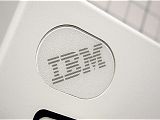 |
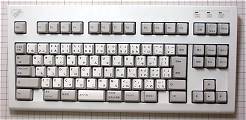 |
IBM 5576-A01(P/N:79F0167)
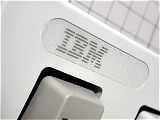 |
 |
Well then, let's take a look at the key unit of 5576-003.
First of all, pull off a key-cap, and then the key-top, you can see a coiled spring.
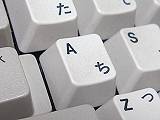 |
 |
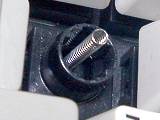 |
If you pull out the black key assemble with a spring...... ha? no switch at all !
But you can see a black rubber sheet covering the metal plate.
The sheet protects the membrane switching sheets and if you push the center of the latching holes then the key switch turns ON.
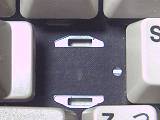 |
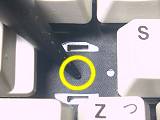 |
A little black resin ( plastic ? ) made hammer with a coiled spring inside a key assemble pushes the rubber sheet and membrane switch beneath a rubber sheet when it is pushed.
See the picture below.
The buckling key of Japanese 5576-003/A01 is constructed with a case/plunger and hammer-lever and each key unit can be removed from the base plate, while Enhanced 101 Model M uses a one-piece molding plate with every cases/plunger molded together with a base resin plate.
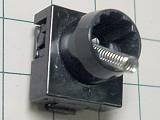 |
 |
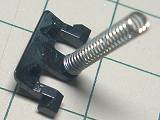 |
 |
Pictures of a cut model* of key housing below show how the buckling spring works.
When you push a key downwards, a coiled spring buckles toward one designated direction and when the spring is completely buckled locking lever at the end of the coil spring hits the rubber sheet, then the membrane contacts beneath the rubber sheet meet together and the switch turns ON.
* Don't worry guys. I used a key to make a cut model from a dead, non-
functional A01 which lost many key units.
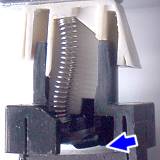 |
 |
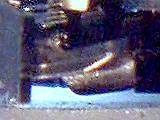 |
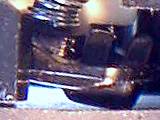 |
In order to make things clear, let's see continuous pictures of key/spring movement to see the buckling spring mechanism works.
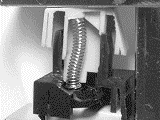 |
Inside a key top, a portion where the upper end of a coil spring meets the key top is slightly tilted so that the spring bends toward the designated direction as shown above.
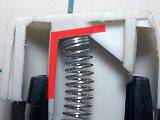 |
Well then, let's look at membrane sheets and switches now.
You will see 5 membrane film sheets consisting of a switching circuit on the base metal plate.
The upper black sheet is made of rubber protecting membrane sheets.
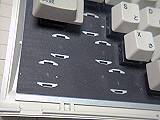 |
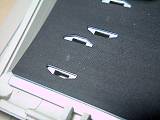 |
 |
Beneath the black rubber sheet, there is a film sheet on which carbon pattern and contact points are printed.
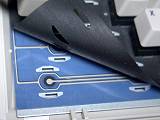 |
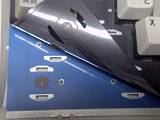 |
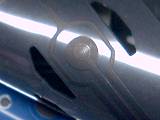 |
And there is another sheet with printed circuit and contact points but if these two sheets are set directly face to face, every contact is "ON" permanently. So there is an another film sheet which has holes just in place of every contacts of both upper and lower membrane sheets to keep the contacts separated unless the upper sheet is pressed.
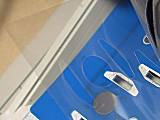 |
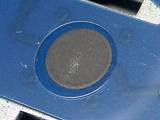 |
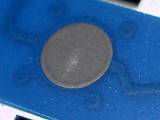 |
Below those film sheets consisting of switches, there is a translucent film sheet.
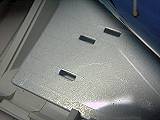 |
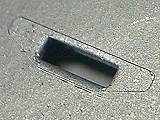 |
Further below the translucent film sheet which separates and protects membrane sheets/switches from the lower metal plate, you will finally reach the base metal plate.
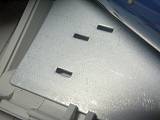 |
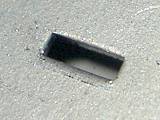 |
Usually keyboards which generate clicky sounds when we type are called Mechanical keyboards while those that give soft touch response are called Membrane. But actually 5576-003, A01 and Enhanced 101 model M use membrane switches. Some Acer made keyboards also give clicky sound using metal springs, but the switch itself is not mechanical but membrane like IBM's buckling keyboards. It may not be so important how we call these keyboards but we'd better to know how they really work and what kind of key switches they use.
Anyway, these IBM clicky-clcking keyboards are "Buckling Spring Keyboards" with non-mechanical switches.
Attention, Model M users.
Model M uses same membrane-sheet switches and you can see the same film sheets between resin-made key base and metal plate. Japanese 5576-003, A01 are derived from Model M and each key units/plungers are look different a bit. But basically the construction of those keyboards are the same.
The switching mechanism of IBM XT 83 key and AT 84 key are based on different architecture called "Capacitive Contacts Switches", though both of them have buckling spring system, but that's another story.
<Update history>
2001/06/20: Published
2002/07/01: Added pictures of 5576-A01
2004/01/20: Completed English translation.(by Sandy. thanks!)
